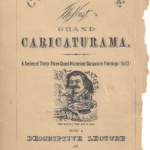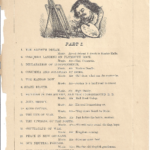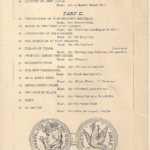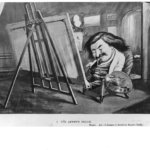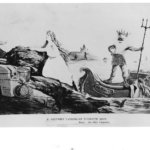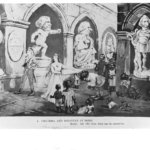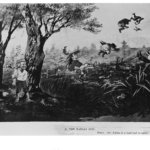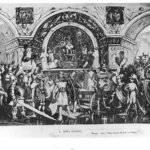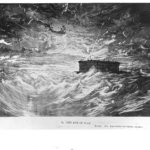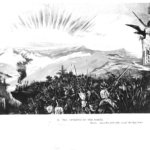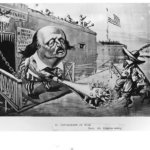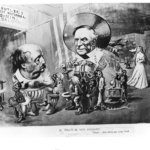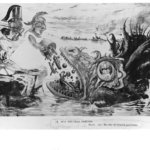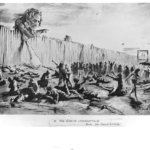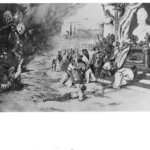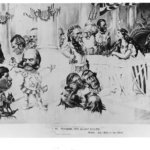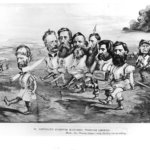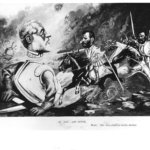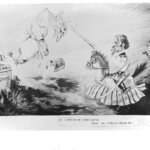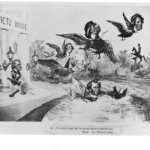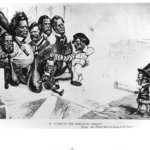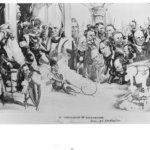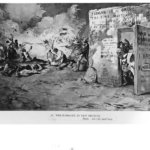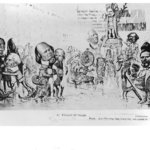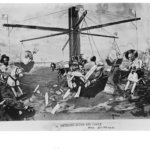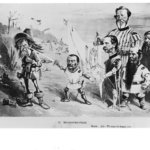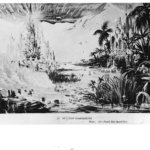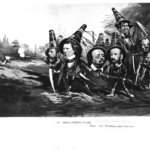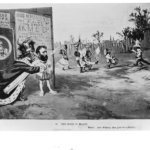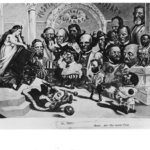Thomas Nast (1840-1902), considered the “father of American political cartooning,” created a series of 33 monumental murals titled The Grand Caricaturama, which was an illustrated history of the United States as told by Nast, in part, in response to the end of the Civil War and Reconstruction.
Nast created The Grand Caricaturama as political theatre. From 1867-1868, he showed the monumental paintings, each measuring approximately 7 x 11 feet, on stage in New York City and Boston accompanied by commentary and live music.
Macculloch Hall Historical Museum is home to two of these monumental paintings, now on permanent display in our Schoolroom Gallery.
The murals in MHHM’s collection are two of eight from the series known to have survived. One surviving mural, “Swinging ‘Round the Circle’,” is on public display two blocks from MHHM at the Morristown & Morris Township Public Library. The remaining 5 murals have been in storage at the Library of Congress since their last public display at The Whitney Museum of American Art, NYC, in 1973.
Public memory of the Civil War and Reconstruction continue to inform American political, cultural, and civic life. In 1867, just two years after the surrender at Appomattox, Thomas Nast (1840-1902) painted “The Last Ditch" and "The Palace of Tears" as stage backdrops for his historical commentary performed as political theater.
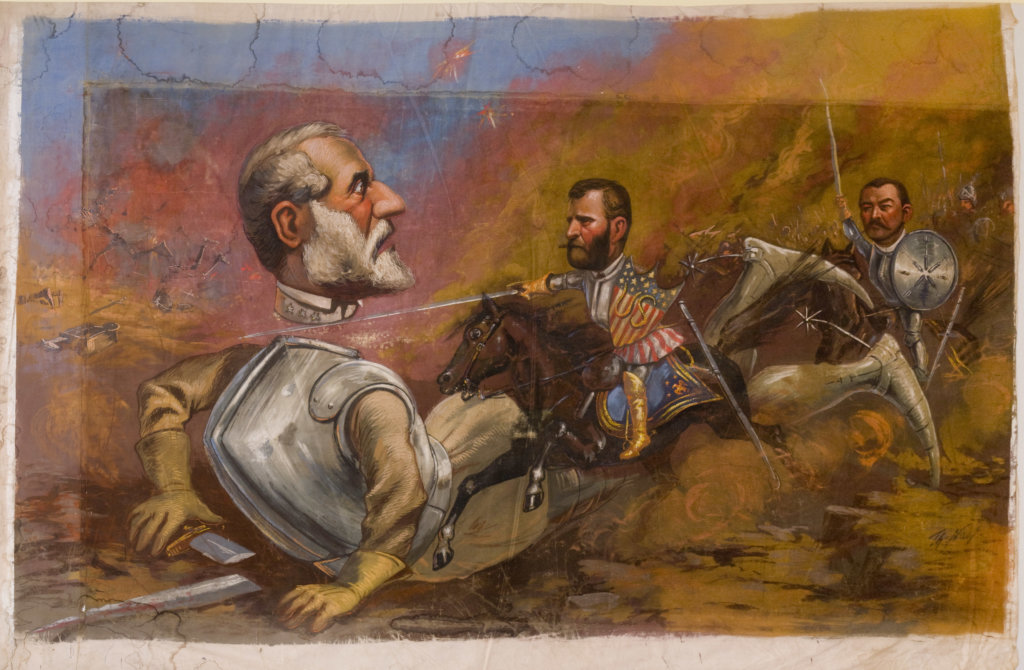
The Last Ditch
Thomas Nast (1840-1902)
1867
Tempera on fabric
TN95.1
"The Last Ditch" depicts Union commander General Ulysses S. Grant and General Philip Sheridan on horseback in pursuit of Confederate General Robert E. Lee. Nast shows Grant calmly and with firm resolve downing the over-life-sized figure of Lee and beheading him. Lee, who has fallen from his horse and broken his bloodied sword, looks back at Grant fully aware of defeat. In the prone, disarmed figure of Lee, Nast shows Grant toppling the Confederacy and the Southern Cause accompanied in the stage performance by the song “Just after the Battle, Mother.”
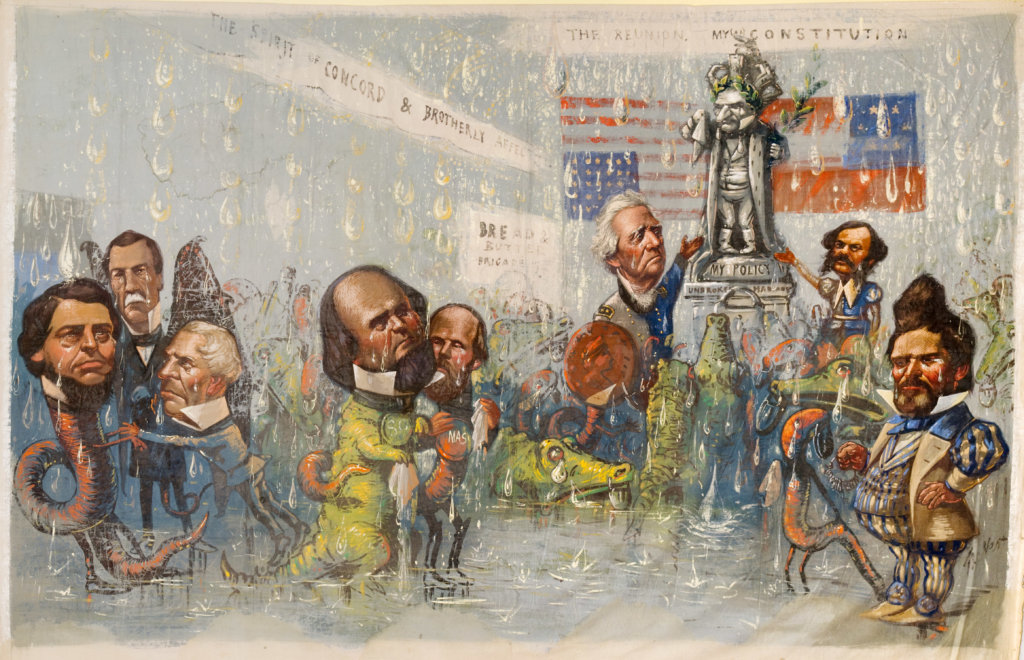
The Palace of Tears
Thomas Nast (1840-1902)
1867
Tempera on fabric
TN2006.40
In "The Palace of Tears" Nast conveys his dismay with the failed promises of Reconstruction by attacking President Andrew Johnson’s pro-South policy. Nast depicts Johnson enshrined as a knock-kneed, tiny monarch atop a pedestal bearing the inscription “My Policy Unbroken Harmony” presiding over the 1866 National Union Convention, which is awash in crocodile tears. In the left foreground, Nast depicts Clement Vallandingham, a pro-Southern peace democrat, with the body of a copperhead snake. During the Civil War, Union supporters referred to Pro-southern peace democrats as “Copperheads” for scheming to undermine the North’s war effort. Behind Vallandingham, Nast illustrates a looming Congressman Fernando Wood, whom he depicts as a winged serpent. Nast frames Wood’s body with large red and black wings, and illustrates a coiled serpent’s tail visible between the figure’s legs. As mayor of New York City before the Civil War, Wood favored the city’s secession from the Union for economic reasons. Nast presented this mural accompanied by the song “The Long, Long, Weary Day, was Passed in Tears Away.” Through "The Palace of Tears" Nast illustrates that the convention, far from a union, was rather a sellout to Southern demands during Reconstruction.
Nast’s murals resonate because they embody themes that are at the root of many current national civic debates. Today, the subject and style of these monumental paintings make them ideal works for engaging high school students in critical discussions of how history informs contemporary civic and political debate.
Conservation and framing of these paintings was funded by a generous grant from the New Jersey Historical Commission. High School program, Thomas Nast and The Grand Caricaturama, was developed in 2022-2023 with a Teacher Advisory Committee thanks to a generous grant from the New Jersey Council for the Humanities. Learn more about school programs and scheduling, here. An abridged version of Thomas Nast and The Grand Caricaturama is available for free, online through Museums for Digital Learning.
To explore all 33 paintings from Nast's The Grand Caricaturama browse the images below:
- Catalogue Page 1 TN2016.06
- Catalogue Page 2 TN2016.06
- Catalogue Page 3 TN2016.06
- Catalogue Page 4 TN2016.06
- The Artists Dream
- Columbia Landing on Plymouth Rock
- Declaration of Independence
- Columbia and Jonathan at Home
- The Kansas Row
- State Rights
- Hunting in the Swamp and the Underground R.R.
- John Brown
- King Cotton
- The Eve of War
- The Uprising of the North
- Contraband of War
- Peace in New Orleans
- Our Neutral Friends
- The Ogre of Andersonville
- Emancipation
- Ulysses The Giant Killer
- Shermans Bummers Marching Through Georgia
- The Last Ditch Collection of Macculloch Hall Historical Museum
- Capture of Jeff. Davis.
- Celebration of Washingtons Birthday
- Gates to the Temple of Liberty
- Coronation of His Highness
- The Massacre at New Orleans
- Palace of Tears Collection of Macculloch Hall Historical Museum
- Swinging Round the Circle On view at the Morristown & Morris Township Public Library
- Reconstruction
- Our New Possessions
- Sour Apple Tree
- Impeachment Scare
- The Boys in Black
- Next
- Au Revoir

